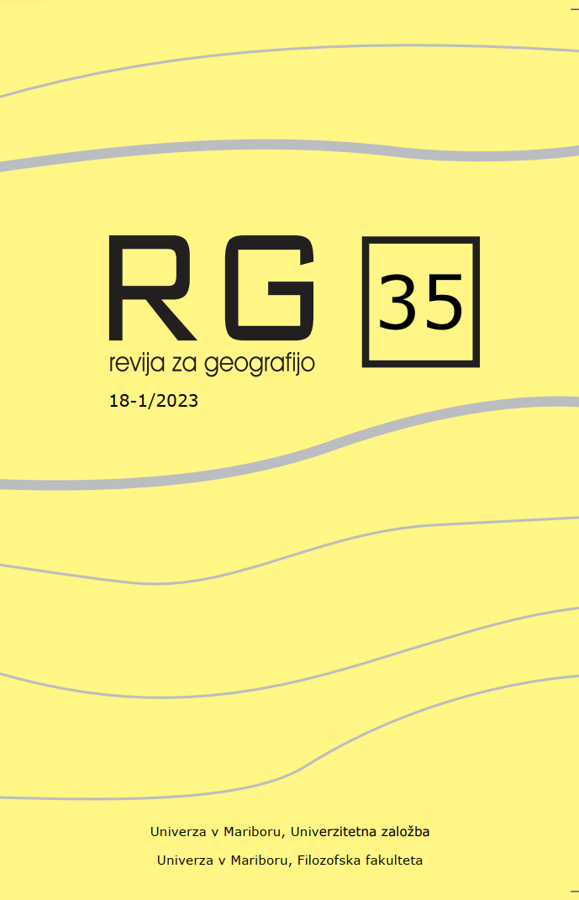Possibilities of food production on land with heavy metals
DOI:
https://doi.org/10.18690/rg.18.1.3361Keywords:
Flood, soil, water, production system, heavy metalsAbstract
Heavy metals present in the soil are incorporated into plants and enter the food chain, causing serious diseases. It is necessary to choose an appropriate cultivation system, which depends on the geographical characteristics of the plot, such as the properties of the soil, bedrock or sediment, slope, exposure, wind direction, surface water runoff and radiation. The article presents an example of the use of flooded land with toxic sludge after floods using vertical systems. These are cultivation approaches where, by loading biomass, we raise the cultivation area and separate it from the base soil. These approaches enable immediate food production in a safe manner, since the root systems of the plants are not in contact with the parent soil.
Downloads
References
Chesapeake Bay Foundation. (2021). What Is Regenerative Agriculture, and Why Is it Re-Emerging Now? Pridobljeno 7. 7 2022 z https://www.cbf.org/blogs/save-the-bay/2021/08/what-is-regenerative-agriculture-and-why-is-it-re-emerging-now.html
Evropska agencija za okolje. (2020). Uvod v kmetijstvo. Pridobljeno 19. 5. 2022 z: https://www.eea.europa.eu/sl/themes/agriculture
Gosar, M., Šajn, R., Bavec, Š., Gaberšek, M., Pezdir, V. in Miler, M. (2019). Geochemical background and threshold for 47 chemical elements in Slovenian topsoil. Geologija, 62(1), 5–57. https://doi.org/10.5474/geologija.2019.001
Jamšek, M. (2023). Izpostavljenost strupenim kovinam in zastrupitve. Univerzitetni klinični center Ljubljana. Pridobljeno z https://www.nijz.si/sites/www.nijz.si/files/uploaded/izpostavljenost_strupenim_kovinam_in_zastrupitve.pdf
Living Soil (2018). [Documentary]. Pridobljeno 11. 12 2021 z https://www.youtube.com/watch?v=ntJouJhLM48
Markelc, I. (2008). Vsebnost težkih kovin v vrtninah, pridelanih na vrtičkih občine Ljubljana. Diplomsko delo. Pridobljeno z https://repozitorij.uni-lj.si/IzpisGradiva.php?id=496&lang=slv
Martinkosky, L., Barkley, J., Sabadell, G., Gough, H. in Davidson, S. (2017). Earthworms (Eisenia fetida) demonstrate potential for use in soil bioremediation by increasing the degradation rates of heavy crude oil hydrocarbons. Science of The Total Environment, 580, 734-743. https://doi.org/10.1016/j.scitotenv.2016.12.020
Mavrič, I. (2014). Vsebnosti težkih kovin v izbranih zeliščih na območju Šoštanja in Zgornjesavinjske doline. Diplomsko delo. Pridobljeno z https://repozitorij.uni-lj.si/IzpisGradiva.php?id=69038&lang=slv
Morgan, J. N. (1999). Effects of processing on heavy metal content of foods. V Impact of processing on food safety (str. 195-211). Pridobljeno z https://pubmed.ncbi.nlm.nih.gov/10335377/
Ožek, K. (2014). Značilnosti vrtnih prsti na območju Mestne občine Celje. Diplomsko delo. Pridobljeno z https://dk.um.si/IzpisGradiva.php?id=43766
Korže, A. V. (2008). Razumevanje pojma» ekosistemski pristop «. Revija za geografijo, 3(2), 39-48.
Rodale Institute. (2021). Regenerative Organic Agriculture. Pridobljeno 30. 11 2023 z: https://rodaleinstitute.org/why-organic/organic-basics/regenerative-organic-agriculture/
Romih, N., Grabner, B. in Lasnik Ribarič, C. (2011). Remediacija onesnaženih tal s težkimi kovinami. Celje: Inštitut za okolje in prostor. Pridobljeno z https://arhiv.kis.si/datoteke/File/kis/SLO/MEH/Biomasa/PRIROCNIK_IOP-1.pdf
Šterbenc, M. (2010). Varstvo rastlin: Varstvo okolja. Biotehniška šola. Pridobljeno z https://www.dlib.si/details/URN:NBN:SI:doc-RYVNMVON
Vernik, T. in Vrščaj, B. (2014). Težke kovine v tleh vrtov. Biobrazda, 2(6). Pridobljeno z https://plus.cobiss.net/cobiss/si/sl/bib/kislj/4449896
Vovk Korže, A. (2007). Vloga prsti v ekosistemu. Dela, 28, 107-119. https://doi.org/10.4312/dela.28.107-119
Vovk Korže, A. (2015a). Ekoremediacija kopenskih ekosistemov. Nazarje: Geaart. Pridobljeno z https://plus.cobiss.net/cobiss/si/sl/bib/282707712
Vovk Korže, A. (2015b). Samoooskrba v praksi. Nazarje: Geaart. Pridobljeno z https://www.nasasuperhrana.si/wp-content/uploads/2017/11/Postanimo_samooskrbni.pdf
Vovk Korže, A. in Janškovec, K. (2009). Čiščenje prsti s pomočjo rastlin. Geografski obzornik, 56(1/2), 14-21.
Vovk, A. (2013). Vpliv zastirke na zadrževanje vlage v prsti. Revija za geografijo, 8(1), 41-55.
Vovk, A. (2022). Varovanje prsti v obdobju podnebnih sprememb. Revija za geografijo, 17(2), 55-68. https://doi.org/10.18690/rg.17.2.2735
Vrhovnik, P. in Vovk Korže, A. (2018). Plastika okoli nas. Poljčane: i Seme.
Vrščaj, B., Kolmanič, A. in Germšek, B. (2023). Remediacija poplavljenih tal in ravnanje z muljem na kmetijskih zemljiščih in vrtovih. Pridobljeno z https://www.gov.si/assets/ministrstva/MKGP/PROJEKTI/POPLAVE-PROJEKT/20230912_RemediacijaPoplavljenihTal-RavnanjeMulji-U
Zadruga Konopko. (2016). Obremenjenost tal na območju Celja. Pridobljeno z https://www.konopko.si/fitoremediacija_s_konopljo
Zaynab, M., Al-Yahyai, R., Ameen, A., Sharif, Y., Ali, L., Fatima, M. in Li, S. (2022). Health and environmental effects of heavy metals. Journal of King Saud University, 34(1). https://doi.org/10.1016/j.jksus.2021.101653
Downloads
Published
Issue
Section
License
Copyright (c) 2023 Ana Vovk

This work is licensed under a Creative Commons Attribution 4.0 International License.
